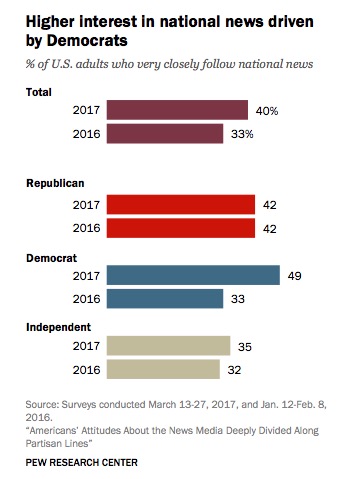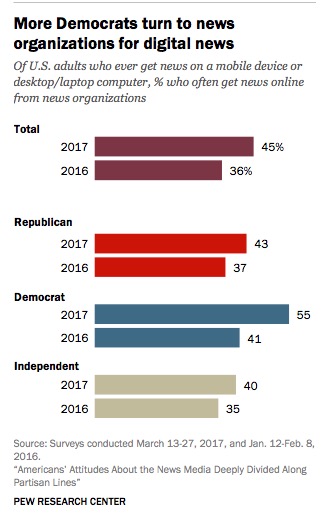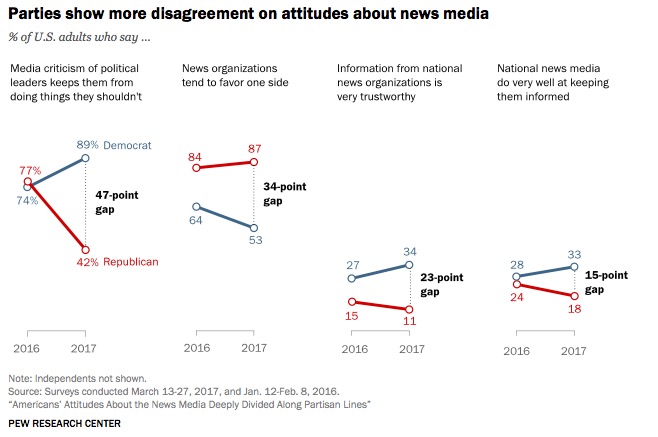It turns out that The Resistance to President Trump is accelerating changes in how many Americans — especially Democrats — are consuming news.
 Americans increasingly prefer to get their news on mobile devices and are accessing more national news, according to a study out Wednesday from the Pew Research Center. These changes are being driven by Democrats; the report also highlights a number of growing divisions in Democrats’ and Republicans’ attitudes about the media.
Americans increasingly prefer to get their news on mobile devices and are accessing more national news, according to a study out Wednesday from the Pew Research Center. These changes are being driven by Democrats; the report also highlights a number of growing divisions in Democrats’ and Republicans’ attitudes about the media.
Pew reports that 45 percent of U.S. adults now “often” get news on mobile devices. That’s an increase from 36 percent last year and 21 percent in 2013. The percentage of Americans who “often” get news on their laptop or desktop stayed practically the same from 2013 through 2017 with 31 percent of U.S. adults saying they “often” read or watch news in that way, according to Pew.
In total, 85 percent of Americans now get news on their mobile devices — the same percentage of people who access news on desktops and laptops, the study said. But of the people who access news on both desktop and mobile, 65 percent prefer consuming it on their mobile devices. That’s up from 56 percent in 2016.
The Pew survey found that the increase in mobile news consumption were primarily driven by Democrats: 52 percent of Democrats surveyed said they now get news on mobile devices often — a 15 percent increase from 2016.
“The gains here were not due to the fact that Democrats tend to be younger than Republicans; in fact, the largest gains were seen among Democrats 50 and older,” the study notes.
 Democrats are also spurring increased interest in national news and are consuming more news directly from news organizations. 40 percent of Americans say they follow national news “very closely” now, up from 33 percent in 2016, the study found — an increase split between a 16 percent increase among Democrats and no change among Republicans. And much as with mobile news consumption, it’s older Democrats who are pushing the growth:
Democrats are also spurring increased interest in national news and are consuming more news directly from news organizations. 40 percent of Americans say they follow national news “very closely” now, up from 33 percent in 2016, the study found — an increase split between a 16 percent increase among Democrats and no change among Republicans. And much as with mobile news consumption, it’s older Democrats who are pushing the growth:
Sharp increases occurred among both Democrats ages 35 to 49 (from 26% who followed national news very closely in 2016 to 44% in 2017) and Democrats 50 and older (from 41% in 2016 to 63% in 2017), while there was no significant change among Democrats ages 18 to 34.
 That increased interest hasn’t carried over to local or international coverage, for which interest has remained steady or declined:
That increased interest hasn’t carried over to local or international coverage, for which interest has remained steady or declined:
Interest in local news actually saw a slight decline (33% follow local news very closely, compared with 37% in 2016) while interest in international and neighborhood did not change significantly. There were also no party-line changes here other than among independents whose interest in local news fell 9 points from 2016 (35% saying they very closely follow local news) to 2017 (26%).
45 percent of people who get news from digital sources also said they often get news directly from news organizations, as opposed to from people they know well or people they don’t know well, the study found: “As with interest in national news, this increase is driven primarily by Democrats (55% often get news this way today, up from 41% in 2016). No significant shifts occurred among Republicans or independents.”
Many news organizations have been able to grow their subscription bases due to this pronounced interest in news. The New York Times, for instance, added 308,000 digital subscribers in the first quarter of 2017, and the paper has positioned itself as a defender of truth with a new advertising campaign that it debuted during the Oscars broadcast.Still, the Pew study found that Democrats and Republicans are sharply divided about what role the media should play.

According to the study, 89 percent of Democrats said it was critical for journalists to play a watchdog role and keep an eye on public officials. Just 42 percent of Republicans agreed. That’s the largest partisan gap since Pew began polling the question in 1985.
“While Republicans have been more likely to support a watchdog role during Democratic presidencies and vice versa, the distance between the parties has never approached the 47-point gap that exists today. The widest gap up to now occurred during the George W. Bush administration, when Democrats were 28 points more likely than Republicans to support a watchdog role.”
Republicans and Democrats also had sharply differing views on whether news organizations favor a particular side, whether information from national news organizations is trustworthy, and whether the national media keeps them informed.

However there is one area where both Democrats and Republicans agree: They both have low levels of trust in social media. Only 5 percent of web-using U.S. adults place a lot of trust in information they get on social media.
The full Pew report is available here.